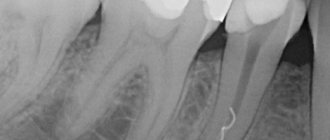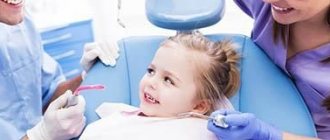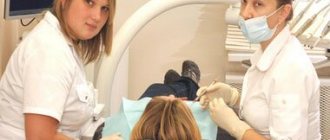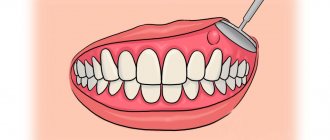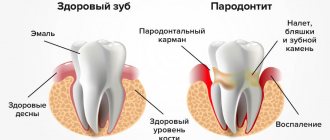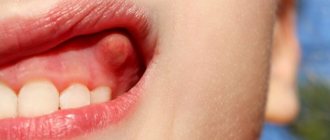Author of the article:
Soldatova Lyudmila Nikolaevna
Candidate of Medical Sciences, Professor of the Department of Clinical Dentistry of the St. Petersburg Medical and Social Institute, Chief Physician of the Alfa-Dent Dental Clinic, St. Petersburg
Purulent pulpitis (also called pulp abscess) is a disease of the dental pulp, which is characterized by the presence of pus in the pulp chamber. Most often it occurs due to improper or unqualified treatment by a doctor.
When the amount of serous matter in the pulp increases, oxygen deficiency occurs. As a result, metabolic processes and acid-base balance are disrupted, which ultimately leads to the accumulation of lactic acid and a decrease in the protective activity of cells. The tissue disintegrates and an abscess forms. When the doctor opens the pulp chamber, the exudate is able to outflow, the pressure in the chamber decreases and the pulp restores its regenerative functions. If the purulent cavity opens spontaneously, then the pus enters the carious cavity, and the pulpitis becomes chronic.
This disease can also be caused by various pulp irritants: strong antibiotics, medicinal pastes, filling materials. In some cases, a broken tooth may be to blame for pulp damage if the fracture line is near the tooth cavity.
Symptoms of purulent pulpitis
The following symptoms are characteristic of purulent pulpitis:
- painful sensations in the tooth for no apparent reason, occurring spontaneously, often the pain is pulsating in nature;
- pain of a constant nature, weakening only for a short time;
- increased pain from any hot foods or drinks, as well as its weakening from any cold foods;
- reaction to sour and sweet foods, which lasts up to half an hour even after stopping contact with the irritant;
- increased pain at night;
- swelling of the oral mucosa near the painful tooth;
- in some cases, gum bleeding and dark enamel color;
- pain not only in one tooth, but throughout the entire oral cavity, in the head and ears.
As a rule, with this disease, the patient even finds it difficult to answer the question of which tooth exactly hurts. In addition, other symptoms are often added to the pain: general weakness, slight fever and malaise.
Diagnosis of purulent pulpitis
First of all, the dentist listens to the patient’s complaints and examines his oral cavity. If during the examination the patient experiences a painful reaction, there is a smell of pus from the oral cavity, and the dentin in the cavity of his tooth is softened, this is a reason to send the patient for an x-ray, which will confirm or refute the diagnosis, and will also allow one to assess the depth of the process. Also, the dentist should be alert to the light shade of dentin or its pigmentation. Often, a diseased tooth and the mucous membrane around it are covered with a white coating, swelling is observed in the transitional fold, and if you press on the tooth, pus may be released.
It is very important to correctly diagnose a disease such as purulent pulpitis, because it is quite easy to confuse it with other dental diseases. Among them:
- Diffuse or focal pulpitis in acute form. This disease is characterized by the absence of pus when opening the dental cavity and not so long-lasting pain.
- Purulent periodontitis. In this case, the patient will experience short-term sharp pain in the tooth, especially when biting.
- Trigeminal neuralgia. Pain at night is not typical for this disease, and it is not aggravated by various temperature stimuli. Most often, painful sensations with this disease appear as a result of touching the skin of the face in certain places.
Causes
There are several causes of the disease:
- Traumatic. The disease occurs due to a bruise, sharp biting on a hard object, or a blow to one tooth. Another possible cause is injury during root canal treatment with dental instruments.
- Infectious. It develops due to the penetration of microorganisms into the tissues surrounding the tooth root. Typically, periodontitis occurs due to Staphylococcus aureus, Streptococcus.
- Medication. Occurs due to the effect of potent drugs on the peri-apical tissues of the tooth. Signs of the disease appear within a few hours after exposure to the drug.
The inflammatory process can occur slowly or very quickly. This does not depend on the cause of its occurrence.
Purulent pulpitis: treatment
The main principle of treating this disease is to rid the canals of pus. But first it is necessary to assess the condition of the pulp. As a rule, pus in the canal causes the pulp to lose its functionality and ability to recover. Therefore, most often, either complete or partial removal of the pulp is required, which is performed under anesthesia.
Purulent pulpitis can affect not only permanent teeth, but also milk teeth, which also need to be treated. In this case, the same methods are used, but the doctor must carefully select the dosage of medications and methods of anesthesia. It is also important to remember that baby teeth have a wider root opening.
The greatest danger is posed by purulent pulpitis in pregnant women. In this case, the doctor should use minimal therapy methods, trying to relieve the patient of pain and associated symptoms, save the tooth and not harm the child. After the treatment, the dentist must monitor the patient’s condition for some time and, if necessary, take emergency measures.
If purulent pulpitis has formed on a wisdom tooth, then treatment here seems inappropriate, so the tooth is immediately removed.
There are two main methods of treating this inflammatory disease.
Vital method of treating purulent pulpitis
In some cases, the vital method can be used to treat purulent pulpitis, the essence of which is to preserve the viability of the root pulp by removing all areas affected by necrosis and carefully filling not only the tooth, but also the dental canals.
This method consists of several steps:
- removal of affected tissues of the carious cavity;
- carrying out treatment with antiseptic drugs;
- removal of pulp from the coronal part of the tooth;
- removal of pulp from the root part of the tooth;
- root canal filling;
- tooth filling.
Devital method of treating purulent pulpitis
As a rule, this method treats a tooth in two stages. During the first visit, the dentist, under anesthesia, opens the tooth and disinfects it, and then puts a special paste into it, which causes the death of the dental nerve. Most often, arsenic anhydride or its more modern analogues are used for this. At the end of the first visit, the doctor places a temporary filling on the tooth.
During the second visit, the dentist removes the temporary filling, then cleans the tooth cavity of pulp and carefully fills the tooth canals. Then he installs the seal.
Which method to prefer
The dentist decides which method to choose in each specific case. Many patients prefer the vital method, because with its help the tooth will be cured in one visit to the dental office. At the same time, you need to understand that only a qualified dentist can remove a living nerve painlessly and without consequences. Otherwise, blood vessels may break, which can ultimately cause periodontitis.
As for the devital method, it is dangerous because arsenic anhydride is used to kill the nerve. If for some reason the patient does not show up to the doctor on the appointed day, then time will be lost and the tooth may have to be removed.
In any case, no matter what method is chosen, after dental treatment it will take some time to return to normal life and forget about the operation. It is quite normal that the patient will continue to feel pain while swallowing or eating for a couple of days. After some time it will pass.
What happens if pulpitis is not treated?
If anyone thinks that to get rid of purulent pulpitis it is enough to take painkillers, they are mistaken. Even if the tooth does not hurt, it will gradually decay and rot, and eventually fall out. Therefore, remedies such as rinsing with vodka or sage, a solution of hydrogen peroxide or propolis are not a panacea for an inflammatory disease, but only a temporary pain reliever.
In no case can purulent pulpitis be treated with traditional methods, because in most cases, “home” treatment will only bring temporary relief, and ultimately lead to tooth loss.
Purulent pulpitis, not treated in time, can lead to acute periodontitis. As a result of this disease, the following may begin:
- inflammation of the bone marrow;
- inflammation of bone tissue;
- decreased immunity;
- damage to the soft tissues of the face.
Also in medical practice, there were cases when patients ignored the disease, and the infection spread throughout the body and caused blood poisoning, which could even lead to death.
Therefore, if for some reason it is not possible to see a dentist right away, you can take a pain reliever, but then immediately visit a dental clinic.
Don't forget: every minute of delay can be fraught with the most negative consequences.
What is periodontitis
Periodontitis is an inflammatory process of the peri-root tissues of the tooth. Pathology develops regardless of a person’s age and gender. The disease is characterized by disruption of the periodontal ligament, destruction of osteocytes, formation of cysts, and loosening of the segment.
The periodontium is a layer of tissue penetrated by blood, lymphatic vessels, and nerve endings. It consists of the gum, alveolar bed and ligament. Due to this complex, each unit is held in its own hole.
The pathogenesis is based on the body's immune response to the inflammatory process. It manifests itself as a vegetative-vascular reaction. Blood flow to the affected area increases, stasis occurs in small vessels, and edema develops. The dentogingival connection is weakened, and under the influence of inflammatory mediators the bone begins to melt. This leads to expansion of the periodontal fissure.
Depending on the provoking factor that caused periodontitis, the following types are distinguished:
| Classification by cause of disease | Notes |
| Infectious | The most common. Periodontal infections are caused by plaque microorganisms. Under their influence, enamel and dentin are destroyed and caries develops. In the absence of medical intervention, microorganisms involve the pulp in inflammation, and pulpitis occurs. Further, along the root canal, the infection descends to the opening in the apex and enters the periapical tissue. In addition, an extra-dental route of infection entering the periodontium from surrounding tissues or hematogenously (periodontitis, osteomyelitis, tonsillitis, etc.) is possible. |
| Drug | Drug-induced periodontitis occurs when the dosage or exposure time of potent drugs during endodontic treatment is not observed. Medicinal substances exit through the root canal into the surrounding tissues, where they have a toxic effect. |
| Traumatic | It is provoked by mechanical impact on periodontal tissue (bruise, blow, improper root filling, etc.). |
The development of the disease is provoked by poor oral hygiene, diabetes, infections of the ENT organs, and metabolic disorders. There is an increased risk of inflammation in smokers and alcohol abusers.
Periodontitis can have a different course:
- acute form. Characterized by a vivid clinical picture. Based on the nature of the exudate, serous and purulent types of the disease are distinguished;
- Chronic periodontitis is a sluggish pathology with erased symptoms. There are fibrous, granulating and granulomatous periodontitis.
Chronic inflammation recurs from time to time. During exacerbation, the clinical picture corresponds to the acute form.
Depending on the location of the lesion, 2 types of dental periodontitis are classified:
- apical (near the root apex);
- marginal (the source of inflammation is located near the edge of the gum).
Prevention of purulent pulpitis
Purulent pulpitis is a rather insidious disease that can develop at any time and in almost every patient. To avoid its occurrence, you need to strictly monitor your oral hygiene, promptly consult a doctor and treat caries and other dental diseases.
It is necessary to visit a specialist even if the slightest symptoms appear in the form of a reaction to cold and hot, pain when biting or pulsation in the tooth.
It is also important to contact only qualified doctors who can provide a high-quality and professional filling. Remember: the better the filling, the longer the tooth will remain healthy.
We hope that the problem of pulpitis will never affect you, and all visits to dentists will be exclusively preventive. Professional toothpaste “ASEPTA PLUS REMINERALIZATION” will help strengthen your teeth and prevent the occurrence of caries and pulpitis.
This product increases the resistance of teeth to the formation of caries; high concentrations of hydroxyapatite and thermal mud help strengthen teeth and gums and reduce hypersensitivity.
Complications
If untimely or incorrectly treated, periodontitis can lead to extensive purulent inflammation and the appearance of multiple ulcers, abscesses and fistulas.
As a result, there is a very serious risk of developing dangerous diseases such as:
- periostitis (flux);
- dental cyst;
- osteomyelitis;
- blood poisoning.
The consequences of each of the complications can be very serious, often accompanied by hospitalization and surgery. Therefore, it is very important to diagnose periodontitis in a timely manner and begin its treatment.
Clinical researches
Clinical studies have proven that regular use of professional toothpaste ASEPTA REMINERALIZATION improved the condition of the enamel by 64% and reduced tooth sensitivity by 66% after just 4 weeks.
Sources:
- Report on the determination/confirmation of the preventive properties of personal oral hygiene products “ASEPTA PLUS” Remineralization doctor-researcher A.A. Leontyev, head Department of Preventive Dentistry, Doctor of Medical Sciences, Professor S.B. Ulitovsky First St. Petersburg State Medical University named after. acad. I.P. Pavlova, Department of Preventive Dentistry
- Clinical and laboratory assessment of the influence of domestic therapeutic and prophylactic toothpaste based on plant extracts on the condition of the oral cavity in patients with simple marginal gingivitis. Doctor of Medical Sciences, Professor Elovikova T.M.1, Candidate of Chemical Sciences, Associate Professor Ermishina E.Yu. 2, Doctor of Technical Sciences Associate Professor Belokonova N.A. 2 Department of Therapeutic Dentistry USMU1, Department of General Chemistry USMU2
- Clinical experience in using the Asepta series of products Fuchs Elena Ivanovna Assistant of the Department of Therapeutic and Pediatric Dentistry State Budgetary Educational Institution of Higher Professional Education Ryazan State Medical University named after Academician I.P. Pavlova of the Ministry of Health and Social Development of the Russian Federation (GBOU VPO RyazSMU Ministry of Health and Social Development of Russia)





